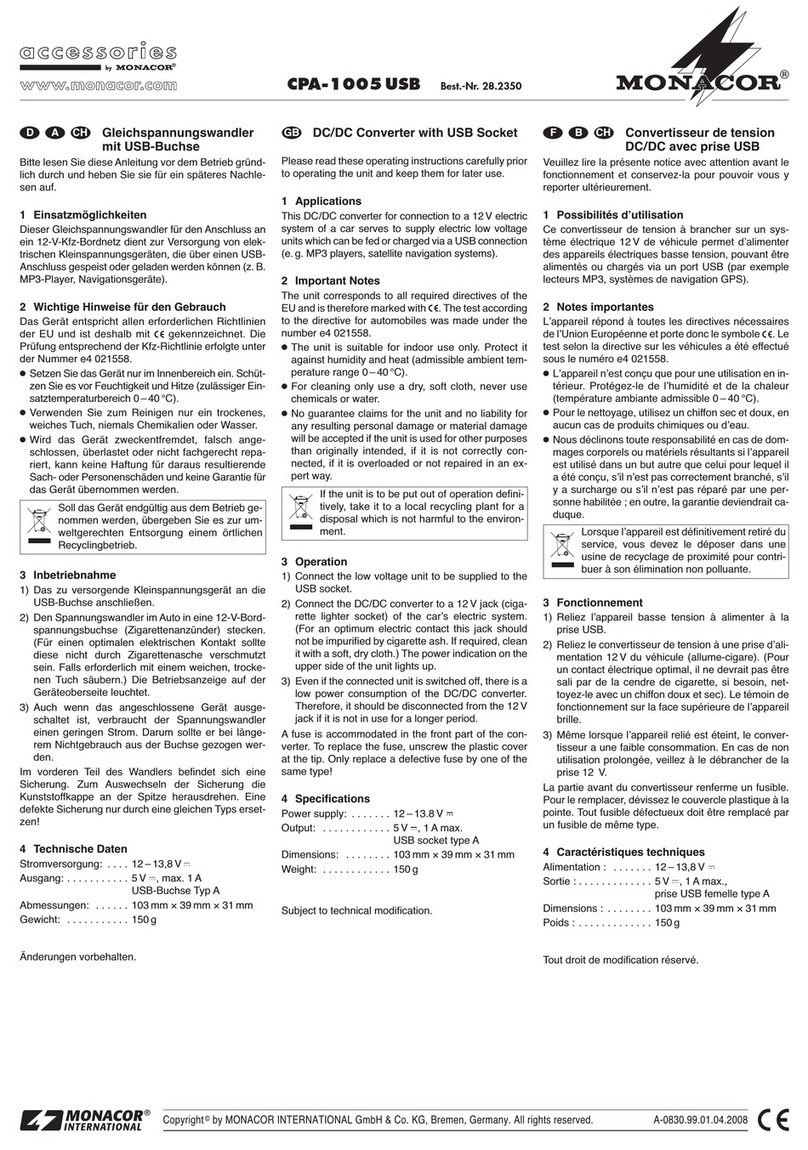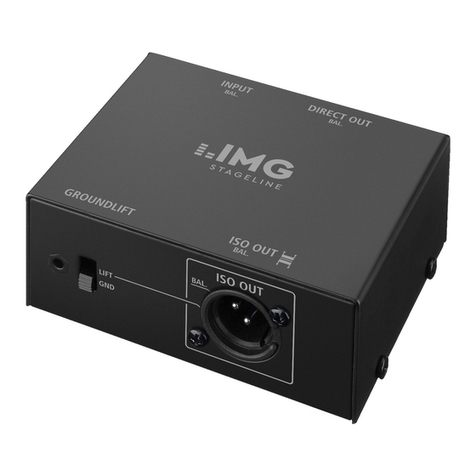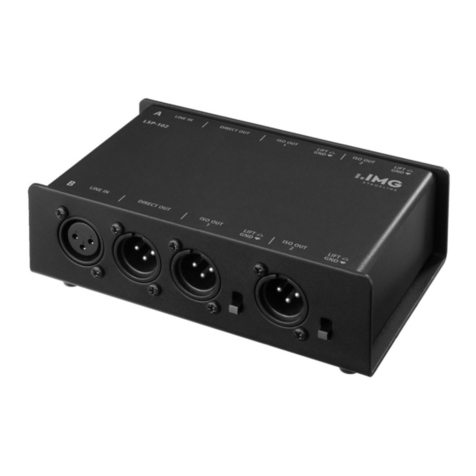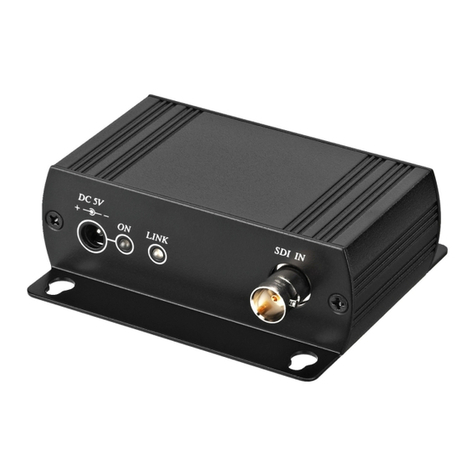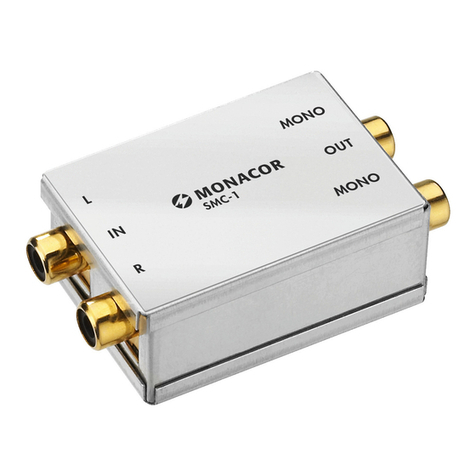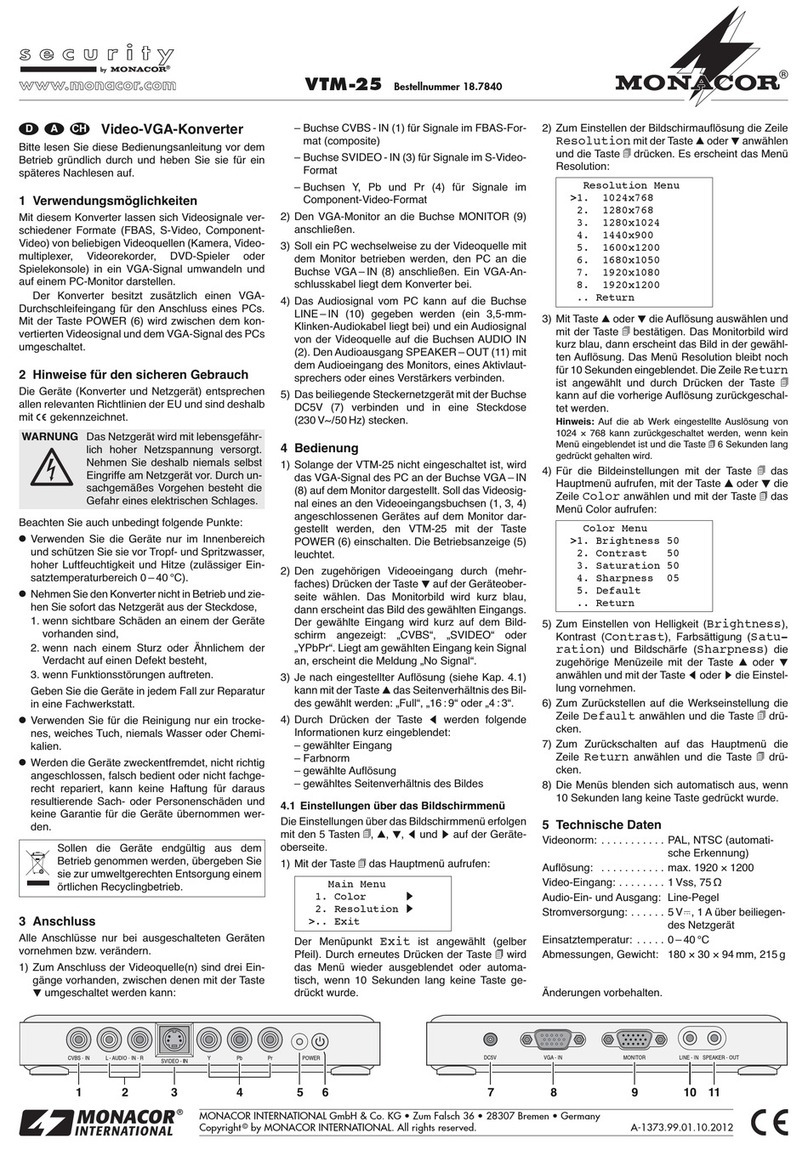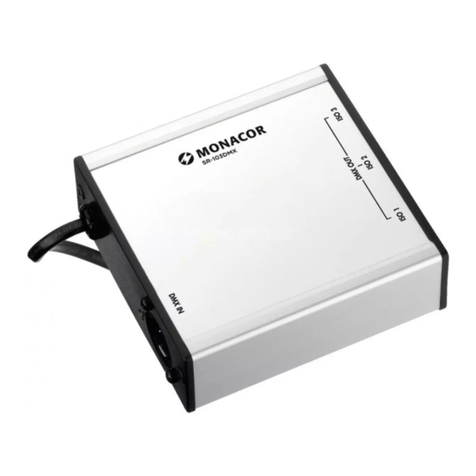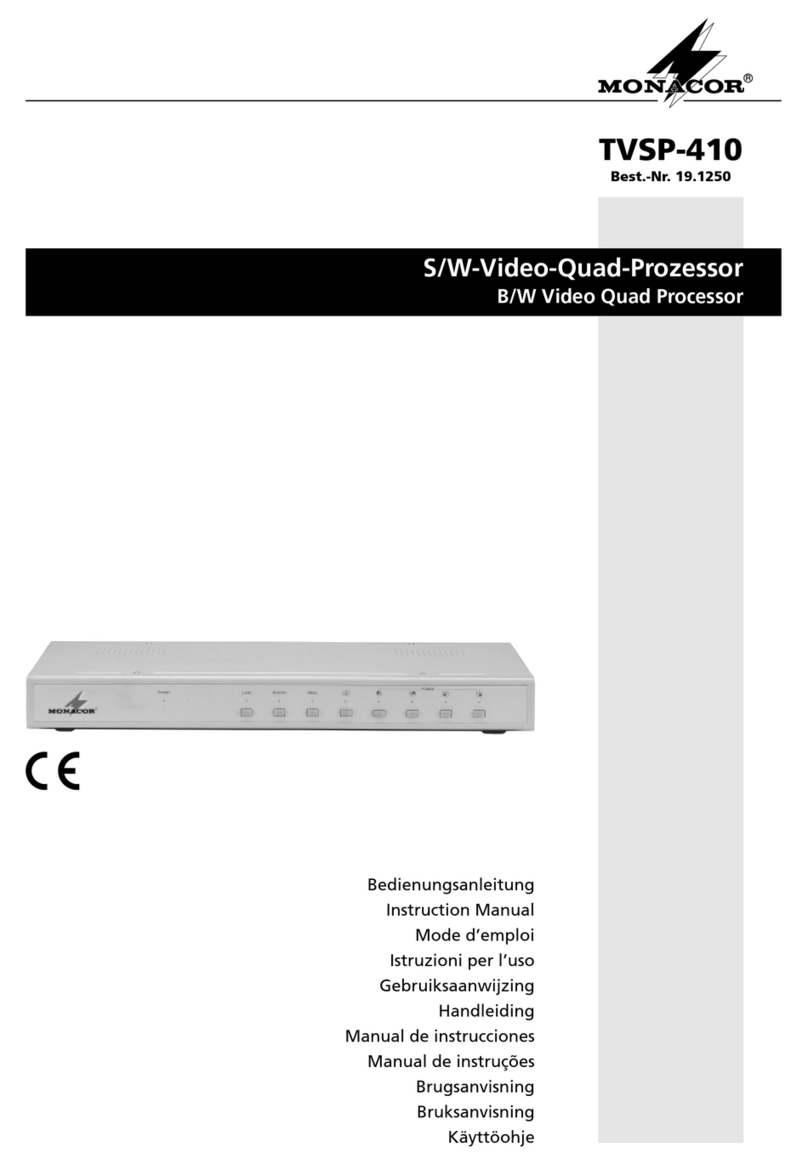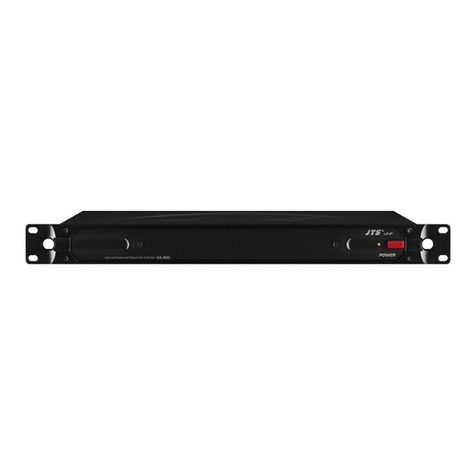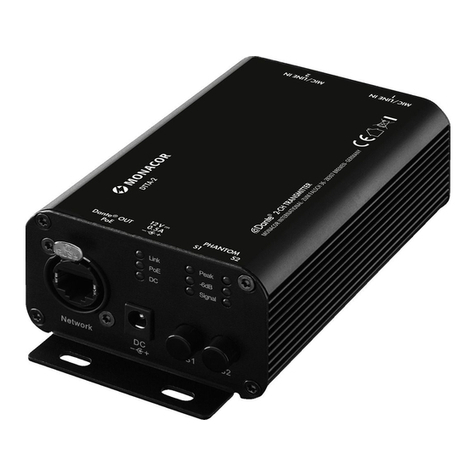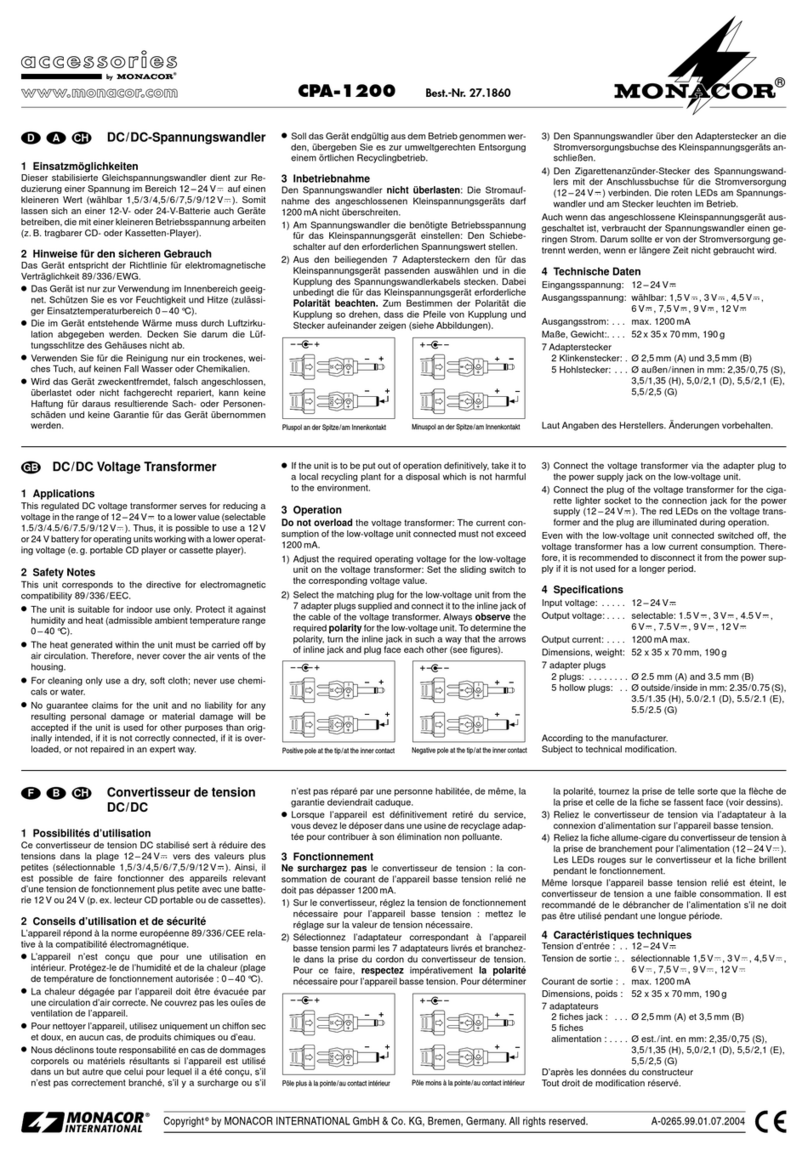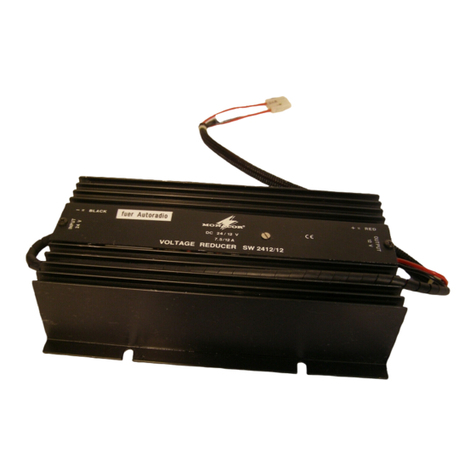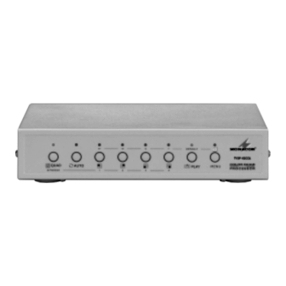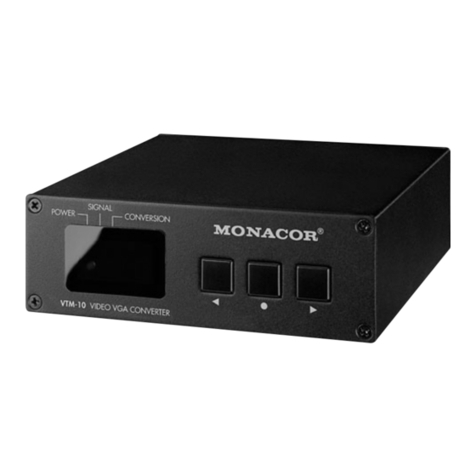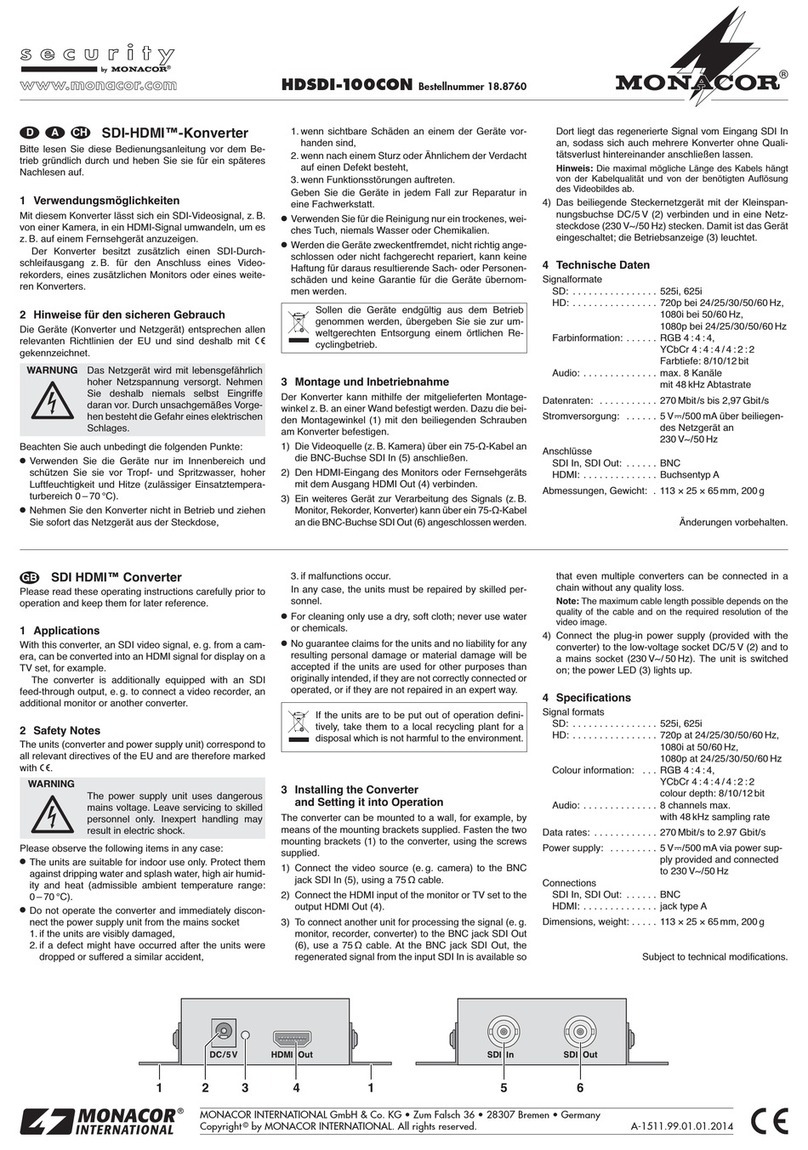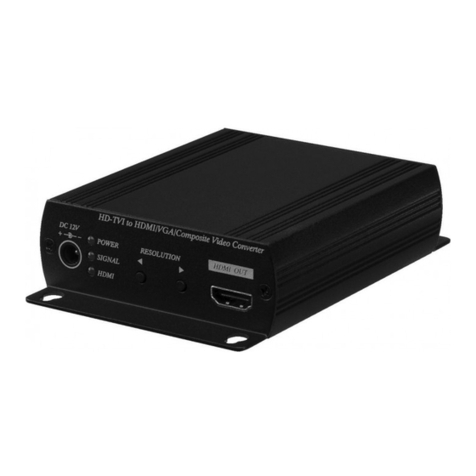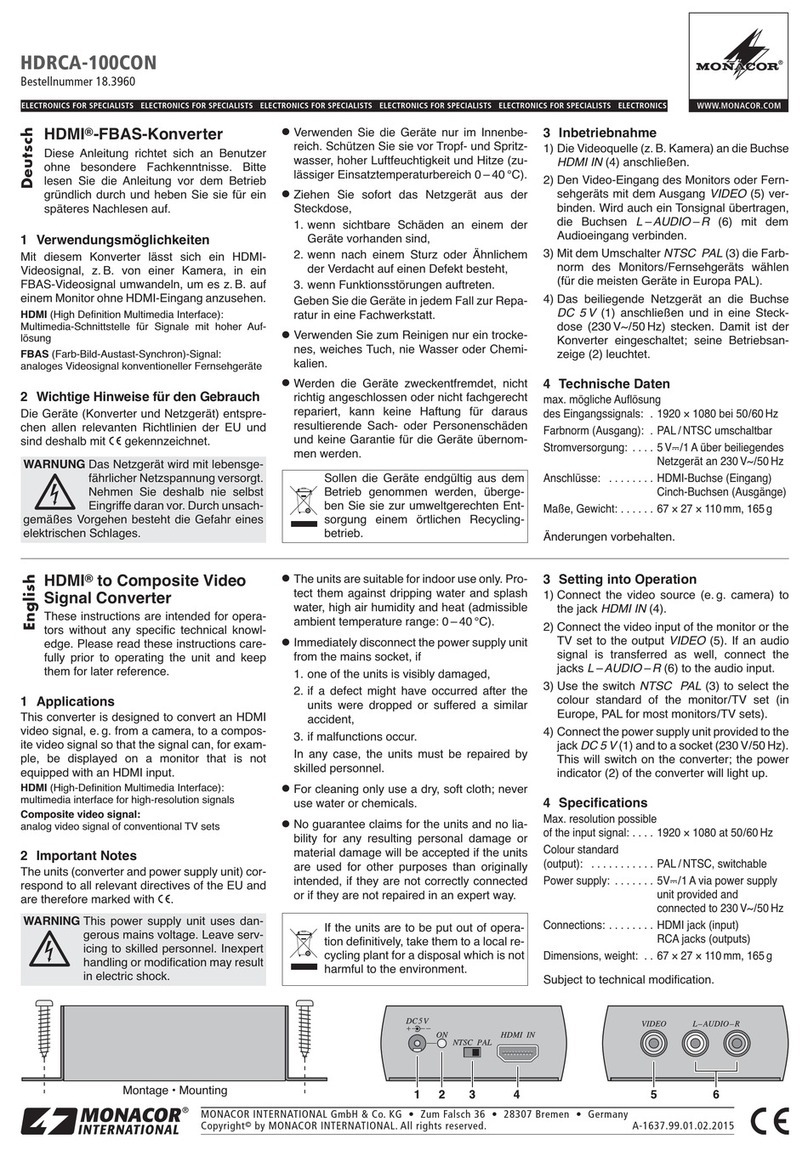MPS-1
Best.-Nr. 24.3790
www.imgstageline.com
Splitter per microfono
Vi preghiamo di leggere attentamente le presenti
istruzioni prima della messa in funzione e di con-
servarle per un uso futuro.
1 Possibilità dʼimpiego
Con lo splitter per microfono MPS-1 è possibile
distribuire un segnale di microfono su due appa-
recchi audio (p. es. mixer principale e mixer moni-
tor). Grazie alla separazione galvanica dellʼin-
gresso (2) e dellʼuscita ISO OUT (3) si evitano
degli anelli di terra.
2 Avvertenze di sicurezza
Il apparecchio è sono conforme a tutte le direttive
richieste dellʼUE e pertanto porta la sigla .
GFar funzionare lʼapparecchio solo allʼinterno di
locali. Proteggerlo dallʼacqua gocciolante e dagli
spruzzi dʼacqua, da alta umidità dellʼaria e dal
calore (temperatura dʼimpiego ammessa fra
0 e 40 °C).
GPer la pulizia usare solo un panno morbido,
asciutto; non impiegare in nessun caso prodotti
chimici o acqua.
GNel caso dʼuso improprio, di collegamenti sba-
gliati o di riparazione non a regola dʼarte del-
lʼapparecchio, non si assume nessuna respon-
sabilità per eventuali danni consequenziali a
persone o a cose e non si assume nessuna
garanzia per lʼapparecchio.
3 Messa in funzione
1) Collegare il microfono con la presa INPUT (2).
2) Collegare le due uscite DIRECT OUT (1) e ISO
OUT (3) ognuna con lʼingresso microfono di un
apparecchio audio.
Se si desidera eliminare lʼapparecchio
definitivamente, consegnarlo per lo smal-
timento ad unʼistituzione locale per il rici-
claggio.
3) Per il momento, spostare lʼinterruttore (4) verso
il basso, in posizione GND. Se nellʼimpianto
audio si è creato un anello di terra (ronzìo
durante i brani a basso volume), spostare lʼin-
terruttore in alto in posizione LIFT. In questo
modo, il collegamento di massa fra lʼingresso e
la presa ISO OUT viene interrotto.
4 Dati tecnici
Gamma di frequenze: . . . 10 – 30 000 Hz
Impedenza
ingresso/uscita: . . . . . . . . 600 Ω
Temperatura dʼesercizio: . 0 – 40 °C
Dimensioni . . . . . . . . . . . . 100 × 80 × 40 mm
Peso: . . . . . . . . . . . . . . . . 310 g
Collegamenti: . . . . . . . . . . XLR, simm.
Con riserva di modifiche tecniche.
Repartidor de micrófono
Lea atentamente las instrucciones de funciona-
miento antes de utilizar el aparato y guárdelas
para usos posteriores.
1 Aplicaciones
El repartidor de micrófono MPS-1 permite distribuir
una señal de micrófono a dos unidades de audio
(p. ej. mezclador principal y mezclador monitor).
A causa de la separación DC de la entrada (2) y de
la salida ISO OUT (3), se previenen zumbidos.
2 Seguridad
El aparato cumple con todas las directivas reque-
ridas por la UE y por tanto está marcado con el
símbolo .
GLa unidad está pensada para usos interiores
exclusivamente. Protegerla contra todo tipo de
proyecciones de aguas, las salpicaduras, la
humedad elevada del aire, y el calor (rango de
temperatura ambiente admisible 0 – 40 °C).
GPar limpiarlo utilizar sólo un trapo seco y suave;
nunca utilizar productos químicos o agua.
G
Rechazamos cualquier responsabilidad en caso
de daños materiales o corporales resultandos si
el aparato se utiliza en otro fin para el cual ha sido
fabricado, si no está correctamente conectado o
reparado por una persona habilitada; por estos
mismos motivos carecería todo tipo de garantía.
3 Funcionamiento
1) Conectar el micrófono la toma INPUT (2).
2) Conectar las dos salidas DIRECT OUT (1) y
ISO OUT (3) cada una a la entrada del micró-
fono de una unidad de audio.
Cuando el aparato esté definitivamente
retirado del servicio, tendrá que deposi-
tarlo en una fábrica de reciclaje adaptada
para su eliminación no contaminante.
3) Por el momento, colocar el potenciómetro des-
lizante (4) en la posición inferior GND. Si se ha
creado un bucle de zumbido en el sistema de
audio (zumbido audible durante melodías de
bajo volumen), colocar el potenciómetro en la
posición superior LIFT. Así, la conexión de
masa entre la entrada y la toma ISO OUT se
interrumpe.
4 Especificaciones
Rango frecuencia: . . . . . . 10 – 30 000 Hz
Impedancia
entrada/salida: . . . . . . . . . 600 Ω
Temperatura
ambiente admisible: . . . . . 0 – 40 °C
Dimensiones: . . . . . . . . . . 100 × 80 × 40 mm
Peso: . . . . . . . . . . . . . . . . 310 g
Conexiones: . . . . . . . . . . . XLR, sim.
Sujeto a modificaciones técnicas.
Rozdzielacz mikrofonowy
Przed rozpoczęciem pracy proszę zapoznać się z
niniejszą instrukcją a następnie zachować ją do
wglądu.
1 Zastosowanie
MPS-1 służy do rozdzielenia sygnału mikrofono-
wego do dwóch urządzeń (np. mikser główny, mik-
ser odsłuchu). Wejście (2) oraz wyjście ISO OUT
(3) jest odizolowane galwanicznie, przez co unika
się problemu przydźwięku sieciowego.
2 Środki ostrożności
Urządzene spełnia wszystkie wymogi norm UE i
dlatego posiadają oznaczenie certyfikatem .
G
Urządzenie jest przeznaczone tylko do użytku
wewnątrz pomieszczeń. Należy chronić przed do-
staniem się jakiejkolwiek cieczy do środka urzą-
dzenia, dużą wilgotnością oraz ciepłem (tempe-
ratura otoczenia powinna wynosić od 0 – 40 °C).
GDo czyszczenia należy używać tylko suchej,
miękkiej ściereczki. Nie wolno używać wody ani
żadnych środków chemicznych.
GNie ponosi się odpowiedzialności za wynikłe
uszkodzenia sprzętu lub obrażenia użytkownika
w przypadku, gdy urządzenia są wykorzysty-
wane w innych celach niż to się przewiduje lub,
jeśli są nieodpowiednio zain- stalowane, użyt-
kowane lub naprawiane.
3 Obsługa
1) Podłączyć mikrofon do gniazda wejściowego
INPUT (2).
2) Podłączyć dwa wyjścia DIRECT OUT (1) oraz
ISO OUT (3) do wejść mikrofonowych urządze-
nia audio.
Aby nie zaśmiecać środowiska po całko-
witym zakończeniu eksploatacji urządzeńe
należy je oddać do punktu recyklingu.
3) Ustawić wstępnie przełącznik (4) w dolnej
pozycji GND. Jeśli w ten sposób powstanie
pętla masy (będzie słyszalny przy niskich gło-
śnościach przydźwięk sieciowy), przełącznik
należy ustawić w pozycji LIFT. W ten sposób
zostanie rozdzielona masa pomiędzy wejściem
a wyjściem ISO OUT.
4 Dane techniczne
Pasmo przenoszenia: . . . 10 – 30 000 Hz
Impedancja
wejściowa/wyjściowa: . . . 600 Ω
Temperatura pracy: . . . . . 0 – 40 °C
Wymiary: . . . . . . . . . . . . . 100 × 80 × 40 mm
Waga: . . . . . . . . . . . . . . . . 310 g
Podłączenia: . . . . . . . . . . XLR, zbalansowane
Z zastrzeżeniem do możliwych zmian.

